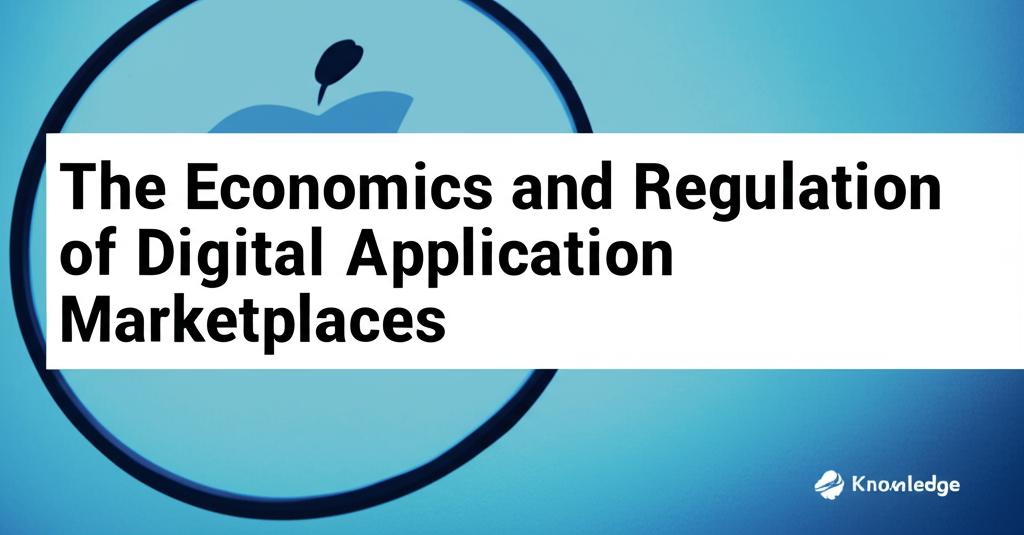Digital application marketplaces, such as Apple's App Store and Google's Play Store, have become central hubs in the digital economy. They act as intermediaries, connecting millions of app developers with billions of users worldwide. Understanding the economics driving these platforms and the evolving regulatory landscape surrounding them is crucial for developers, consumers, and policymakers alike.
Economic Dynamics of App MarketplacesThese marketplaces operate as two-sided platforms, generating significant network effects. More users attract more developers, leading to a wider variety of apps, which in turn attracts more users. This positive feedback loop often results in market concentration, with a few dominant players emerging.
Key economic characteristics include:
- Gatekeeping Power: Dominant marketplaces control access to vast user bases. They set the rules for app discovery, distribution, security standards, and content moderation. This gatekeeper role gives them considerable influence over the app ecosystem.
- Monetization Strategies: The primary revenue source for major app stores has traditionally been commission fees, typically ranging from 15% to 30% on paid apps, in-app purchases, and subscriptions. While there have been adjustments, particularly for smaller developers or specific subscription models, these fees remain a significant aspect of the business model and a point of contention. Other revenue streams include advertising within the store.
- Innovation and Investment: Marketplaces facilitate innovation by providing developers with tools, infrastructure (APIs), and access to a global market. However, the platform owners' control and commission structures can also influence developers' incentives and business models, potentially stifling certain types of innovation or favouring apps that align with the platform's interests.
- Data Utilization: App marketplaces gather vast amounts of data on user behaviour, preferences, and app performance. This data is valuable for improving the platform, personalizing user experiences, targeted advertising, and potentially informing the platform owner's own app development strategies.
The significant economic power wielded by dominant app marketplaces has attracted increasing scrutiny from regulators worldwide. Concerns primarily focus on competition, fairness, consumer protection, and data privacy.
Key regulatory issues and developments include:
- Antitrust and Competition: Regulators are investigating whether practices like high commission fees, mandatory use of proprietary in-app payment systems, self-preferencing (favouring the platform owner's own apps), and restrictions on alternative distribution channels (like side-loading or competing app stores) constitute abuses of dominant market positions.
- The EU's Digital Markets Act (DMA): This landmark regulation designates major platform operators like Apple and Google as "gatekeepers" and imposes specific obligations and prohibitions. For app marketplaces, this includes requirements to allow alternative app stores, permit side-loading (installing apps from outside the official store, albeit with security considerations), grant developers access to alternative payment systems, ensure fair and non-discriminatory access terms, and provide developers with access to data generated through the platform. Compliance deadlines and ongoing implementation efforts are shaping the market in Europe and potentially influencing regulations elsewhere.
- Global Scrutiny: Beyond the EU, countries like the United States, the United Kingdom, Japan, South Korea, and Australia are actively debating or implementing regulations targeting digital platforms. Investigations, lawsuits, and legislative proposals often focus on app store payment policies, restrictions on developers, and the overall competitive landscape.
- Fairness to Developers: Regulations aim to ensure developers are treated fairly. This includes transparency in app review processes, clear and consistently applied rules, reasonable commission fees, and the ability to communicate directly with their customers.
- Consumer Choice and Security: While regulations aim to increase choice (e.g., through alternative stores or payment systems), platforms often raise concerns about potential impacts on user security, privacy, and the overall user experience. Regulators are grappling with balancing increased competition and choice with maintaining robust security standards.
- Interoperability: Mandates promoting interoperability between platforms and services are being considered, potentially allowing data and services to work more seamlessly across different ecosystems, reducing lock-in effects.
The interplay between the economic forces driving digital application marketplaces and the regulatory interventions aimed at curbing potential harms is ongoing. We are witnessing a shift towards greater openness, driven by regulations like the DMA, forcing dominant platforms to adapt their business models. This includes adjustments to commission structures, allowing alternative payment options, and enabling greater flexibility in app distribution. However, the effectiveness of these regulations, the technical implementation details, and the platforms' responses will continue to shape the future of app discovery, distribution, monetization, and innovation in the years to come. The balance between fostering competition, protecting consumers, and maintaining the security and functionality of these vital digital ecosystems remains a central challenge.

